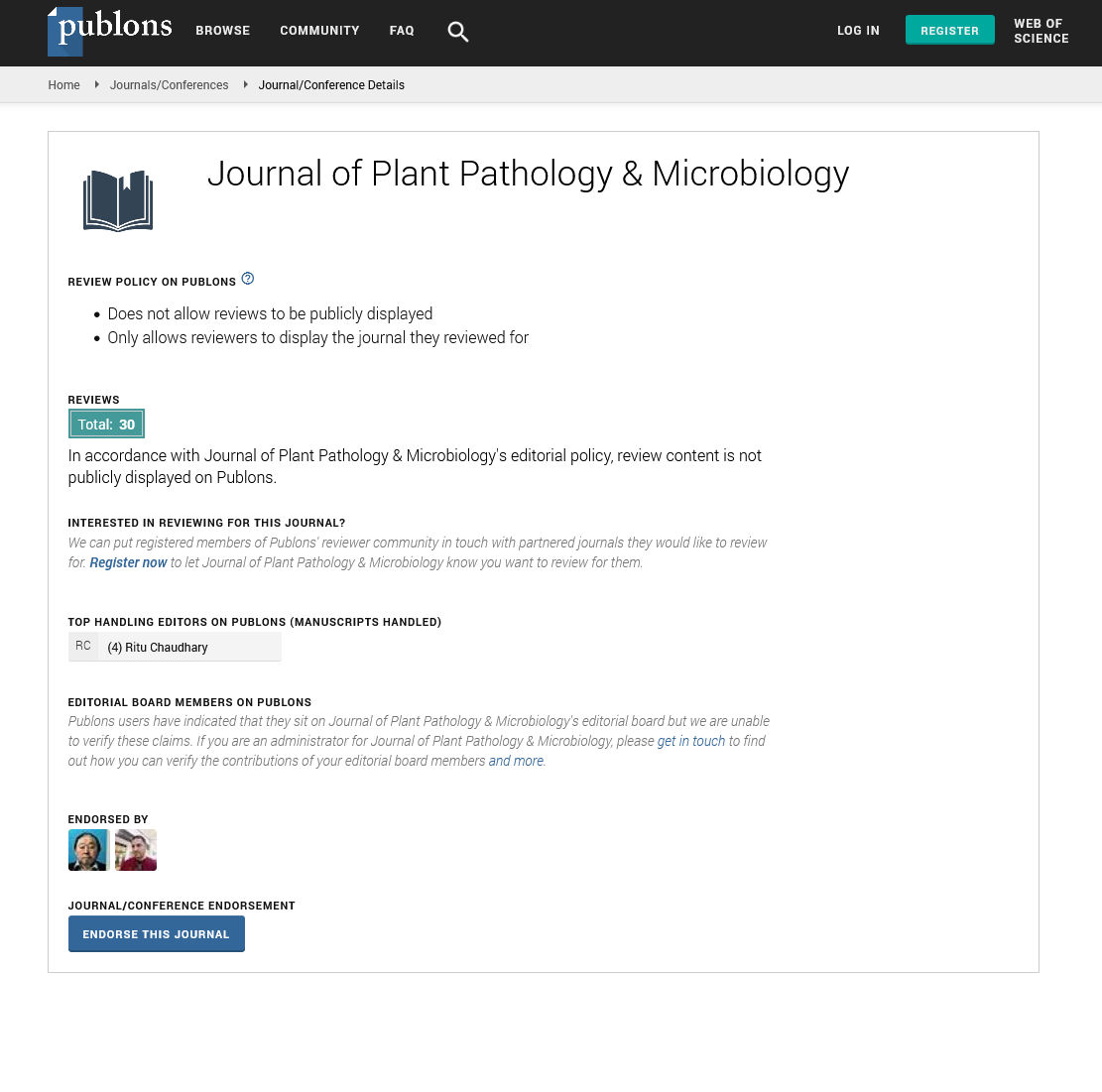Indexed In
- Open J Gate
- Genamics JournalSeek
- Academic Keys
- JournalTOCs
- CiteFactor
- Ulrich's Periodicals Directory
- Access to Global Online Research in Agriculture (AGORA)
- Electronic Journals Library
- Centre for Agriculture and Biosciences International (CABI)
- RefSeek
- Directory of Research Journal Indexing (DRJI)
- Hamdard University
- EBSCO A-Z
- OCLC- WorldCat
- Scholarsteer
- SWB online catalog
- Virtual Library of Biology (vifabio)
- Publons
- Geneva Foundation for Medical Education and Research
- Euro Pub
- Google Scholar
Useful Links
Share This Page
Journal Flyer
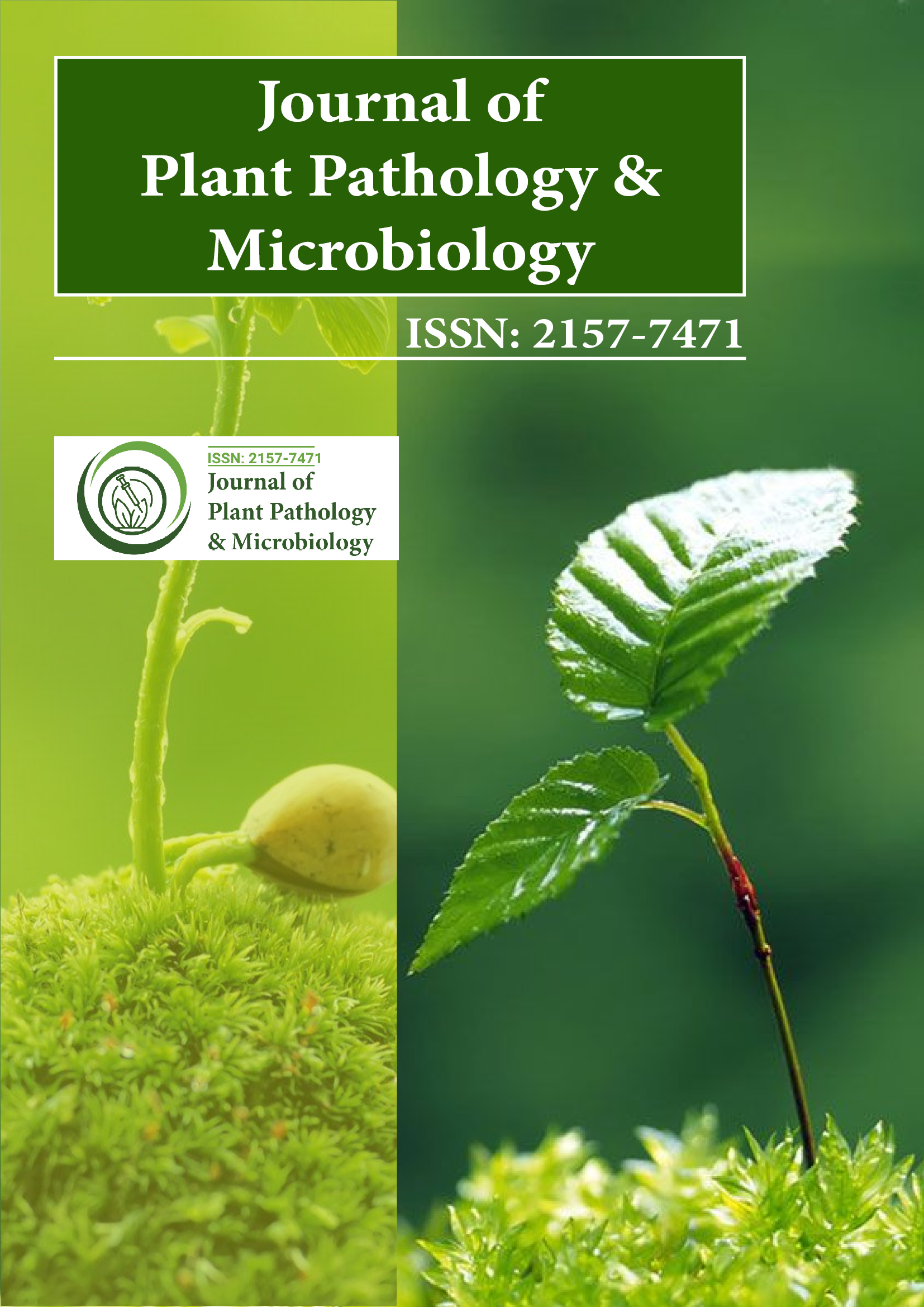
Open Access Journals
- Agri and Aquaculture
- Biochemistry
- Bioinformatics & Systems Biology
- Business & Management
- Chemistry
- Clinical Sciences
- Engineering
- Food & Nutrition
- General Science
- Genetics & Molecular Biology
- Immunology & Microbiology
- Medical Sciences
- Neuroscience & Psychology
- Nursing & Health Care
- Pharmaceutical Sciences
Research Article - (2023) Volume 15, Issue 4
Critical Time of Fungicide Spray for the Management of Stem Rust (Puccinia graminis f.sp. tritici) and its Effect on Grain Yield, Yield Components and Protein Content of Durum Wheat (Triticum durum L.)
Ermias Teshomea*Received: 17-Jul-2023, Manuscript No. JPPM-23-22224; Editor assigned: 19-Jul-2023, Pre QC No. JPPM-23-22224 (PQ); Reviewed: 03-Aug-2023, QC No. JPPM-23-22224; Revised: 21-Dec-2024, Manuscript No. JPPM-23-22224 (R); Published: 28-Dec-2024, DOI: 10.35248/2157-7471.24.15.741
Abstract
The trial was conducted during the main season at Sinana Agricultural Research Centre (SARC) for two seasons (2020/21-2021/22). To assess the appropriate fungicide spray time for stem rust management and effect of fungicide spray on grain protein content and the financial profitability of the fungicide spray practice for the management of stem rust. The field experiment was designed using RCB design in three replications involving two durum wheat varieties (Bulala and Bekelcha) and Rex® Duo sprayed at different time and frequency. The highest mean stem rust severity of 40.19% was recorded from unsprayed Bekelcha variety while the lowest stem rust severity of 0.81% was recorded from Bekelcha variety sprayed 3 times at 14 days interval before disease occurrence. The highest protein content of 13.10% was recorded from Bekelcha variety sprayed twice at 14 days interval with the first spray being before disease occurrence and the lowest grain protein content (11.77%) was recorded from Bulala variety sprayed 3 times at 14 days interval with the first spray being before disease occurrence. Therefore, wheat growers in Bale and similar agro-ecologies are recommended to produce Bulala variety sprayed 2-3 times at 14 days interval, the first spray be started immediately as the first stem rust pustule is observed on the plant surface of the surrounding farms.
Keywords
Stem rust; Disease severity; Durum wheat; Fungicide; Fungicide spray time
Introduction
Durum wheat (Triticum durum or Triticum turgidum subsp. durum) is among the very important food crops grown in the world, with an estimated 36 million tons of annual global production. Similarly, it is one of the most vital cereal crops widely cultivated in a wide range of altitudes in Ethiopia. It is considered as one of the main staple food crops for about 36% of the Ethiopian population. However, its production and quality is highly affected by various abiotic and biotic factors. Stem rust (Puccinia graminis f.sp. tritici) is becoming the major biotic factors constraining durum wheat production in Ethiopia. In the global scale, cereal rusts are the most destructive diseases of wheat in general and durum wheat in particular. Stem rust or also called black rust is caused by the basidiomycete fungus Puccinia gramini sf. sp. tritici, has been the most devastating of all wheat diseases under favorable conditions.
It mainly attacks wheat but can also infect many other small cereals including barley, oat, rye and forage grasses. It is capable of severely affecting durum wheat (Triticum turgidum L. var. durum). Traditionally, it was assumed that the occurrence of stem rust epidemics is observed in areas where wheat is commonly cultivated. Fear for this pathogen has increased again after the emergence of Ug99 (TTKSK) race in Uganda in 1998, because this race and its derivatives overcame a number of resistance genes and converted the resistant cultivars in to susceptible [1].
Highlands of Bale is considered as one of the evolution center of stem rust races in Ethiopia because of the year round production of wheat. The second most dominant and devastative stem rust race was TKTTF evolved in Arsi and Bale areas and caused localized stem rust epidemics in Bale and Arsi in 2013 that has caused 100% loss of grains in most of the fields.
To combat this challenging factor, use of fungicide is one of the most common durum wheat production packages in Bale. Currently, Bale farmers spray fungicides before the stem rust occurrence to protect the crop before its symptom appears on plants. Therefore, this study was initiated to determine the appropriate fungicide spray time, determine the financial profitability of fungicide spray practice and to examine the effect of stem rust on protein content of durum wheat [2].
Materials and Methods
Description of experimental area
The field experiment was conducted at Sinana Agricultural Research Center (SARC) on-station trial site Bale, Ethiopia during 2020/21 and 2021/22 main cropping seasons. SARC is located at 463 km distance from the central city Addis Ababa to the South-East [3-6]. Geographically SARC is located at 07° 07’ N latitude and 40° 10’E longitude on an elevation of 2400 masl. The area receives 750-1000 mm mean annual rain fall and have mean annual temperature of 9°C-21°C.
Treatments and design
The experiment was laid out in Randomized Complete Block Design (RCBD) with 3 replications. Durum wheat varieties Bulala and Bekelcha that have moderate resistance and susceptible reactions, respectively to stem rust were used in this study.
| Treat. | Treatment combination |
|---|---|
| 1 | Bulala with no fungicide. |
| 2 | Bulala with once at tillering before disease occurrence. |
| 3 | Bulala with twice at tillering at 14 days interval with the first spray starts before disease occurrence. |
| 4 | Bulala with three times at tillering at 14 days interval with the first spray starts before disease occurrence. |
| 5 | Bulala with twice at tillering at 21 days interval with the first spray starts before disease occurrence. |
| 6 | Bulala with three times at tillering at 21 days interval with the first spray starts before disease occurrence. |
| 7 | Bulala with once after the first observable symptom. |
| 8 | Bulala with twice after the first observable symptom at 14 days interval. |
| 9 | Bulala with three times after the first observable symptom at 14 days interval. |
| 10 | Bulala with twice after the first observable symptom at 21 days interval. |
| 11 | Bulala with three times after the first observable symptom at 21 days interval. |
| 12 | Bekelcha with no fungicide. |
| 13 | Bekelcha with once at tillering before disease occurrence. |
| 14 | Bekelcha with twice at tillering at 14 days interval with the first spray starts before disease occurrence. |
| 15 | Bekelcha with three times at tillering at 14 days interval with the first spray starts before disease occurrence. |
| 16 | Bekelcha with twice at tillering at 21 days interval with the first spray starts before disease occurrence. |
| 17 | Bekelcha with three times at tillering at 21 days interval with the first spray starts before disease occurrence. |
| 18 | Bekelcha with once after the first observable symptom. |
| 19 | Bekelcha with twice after the first observable symptom at 14 days interval. |
| 20 | Bekelcha with three times after the first observable symptom at 14 days interval. |
| 21 | Bekelcha with twice after the first observable symptom at 21 days interval. |
| 22 | Bekelcha with three times after the first observable symptom at 21 days interval. |
Table 1: Treatment combination.
The disease severity gradient was created by spraying a fungicide Rex® Duo at a rate of 0.5 l/ha in different combinations with the two durum wheat varieties (Table 1). The size of each plot was 1.8 m × 1.5 m which will contain 9 seeding rows. Between row, plot and block spaces were 0.2 m, 1 m and 1.5 m, respectively. The seed rate was 150 kg/ha and fertilizers rates were 100 kg/ha NPS and 50 kg/ha UREA. All other field management practices including weeding were applied equally for all plots as non-experimental variable [7-10].
Collected data
Stem rust severity data were collected on a plot bases according to the modified cobb-scale method. Thousand Kernel Weight (TKW (g)) was measured as a weight of 1000 randomly sampled grains. Whereas, grain yield (kg/ha) was measured as a total weight of durum wheat grains harvested from the five middle rows and adjusted to 12% moisture level. Effect of stem rust on durum wheat grains protein content was assessed by using nearinfrared spectrometry at SARC grains quality laboratory [11-14].
Partial budget analysis
The overall production costs and benefits from each treatment were investigated following the method developed by CIMMYT. According to this method, the partial budget analysis was performed through considering Total Variable Costs (TVC). Sale Revenue (SR) was calculated as total income from each treatment from the sale of durum wheat grains at 39 Ethiopian Birr (ETB) per kilogram of the grains. The Marginal Cost (MC) was computed from variable costs and Marginal Benefit (MB) was calculated as a difference between marginal costs sale revenue. The Marginal Rate of Return (MRR) was calculated considering the SR and TVCs. The total costs spent on fungicide purchase, water purchase and transport, rent of sprayer, labor cost for fungicide spray, water supply and cleaning of equipment’s were the main TVCs considered in this analysis [15].

Where,
DNI: Difference in Net Income compared with control,
DIC: Difference in Input Cost compared with control.
Data management and statistical analysis
Independent variables from each treatment were analyzed using the logistic model (ln (Y/1Y)), Van der Plank, following the Statistical Analysis System (SAS) procedure. The mean separation technique LSD was used with a probability of 5% to identify the statistical difference between the means of the treatments. The Area Under the Disease Progress Curves (AUDPC) and apparent infection rate (r) was calculated. ANOVA was performed for the disease severity, AUDPC, apparent infection rate (r), TKW and grain yield (kg/ha) according to the SAS procedure. Correlation and regression analyses were employed to assess the relationships between disease and agronomic parameters [16].

Where,
Xi=the PSI of disease at the ith assessment
ti=is the time of the ith assessment in days from the first assessment
date
n=total number of disease assessments
Results and Discussion
The over years combined analysis of variance have shown statistically significant (P<0.05) differences between fungicide spray time treatments on stem rust severity. In this trial, fungicide spray time has significantly influenced the progress of stem rust severity on the two varieties almost similarly (Figure 1). At the initial stage, although the difference between treatments for stem rust severity was statistically significant (P<0.05), the difference was highly negligible. This is common that at the early stage of disease development, the difference between treatments is small. The highest mean stem rust severity of 40.19% was recorded from unsprayed Bekelcha variety and the second highest stem rust severity of 29.23% was recorded from unsprayed Bulala variety. In contrary, the lowest stem rust severities of 0.81% and 0.88% were recorded from Bekelcha variety that has received Rex® Duo sprays of 3 times at 14 days interval before disease symptom is developed on plants and 2 times at 21 days interval disease symptom is developed, respectively [17].
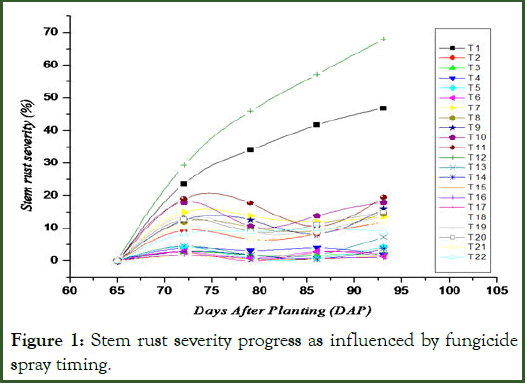
Figure 1: Stem rust severity progress as influenced by fungicide spray timing.
Result similar to this was previously reported by Tadesse et al., where a fungicide Tilt® 250 E.C. highly reduced the severity of stem rust infection on wheat. The role of fungicides in reducing the stem rust severity pressure and the time of fungicide application clearly created variability on stem rust disease severity and grain yield productivity of durum wheat. Experiments conducted so far focused on determining wheat growth stages at which spraying has to be commenced. In Kenya, it was reported that the lowest AUDPC was recorded from plots sprayed by fungicide at tillering and flowering growth stages sequentially. However, the occurrence of stem rust these days is surprisingly at very early stage of wheat growth before tillering. To fill this gap, the laboratory experiment conducted resulted in very law level of rust when fungicide was applied before inoculation of the pathogen on the host plant compared with fungicide application after inoculating the pathogen on the host plant. In line with this, spraying the fungicide when very small level of stem rust pustule is observed on wheat is recommended [18].
ANOVA for grain protein content (%) showed the existence of statistically significant (P<0.05) difference. The highest protein content (13.10%) was recorded from Bekelcha variety that received fungicide application twice at 14 days interval with the first spray being before disease occurrence. Whereas, the lowest grain protein content (11.77%) was recorded from Bulala variety that received the fungicide spray 3 times at 14 days interval with the first spray being before disease occurrence (Table 2). As described by several researchers and this study as well, the effect of fungicide spray on grain protein content is reverse, i.e., fungicide spray reduces the total grain protein content. In line with this result, the report indicated that stem rust increased the total grain content in durum wheat and low total grain protein was recorded from fungicide sprayed plots. Similarly, stripe rust and leaf rust resulted in shriveling of grains that results in an increased grain protein content. Similarly, ANOVA showed statistically significant (P<0.05) difference between treatments for agronomic parameters evaluated. The highest TKW (50 g) was recorded from Bekelcha variety sprayed twice at 14 days interval with the first being before disease symptom is observed. The second highest TKW (49.6 g) was recorded from a variety Bekelcha that received fungicide sprays 3 times at 14 days interval and 2 times at 21 days interval with the first spray before disease symptom. Fungicide application and timing of fungicide spray highly influenced the TKW of each variety [19].
| Treatment | Initial SR (%) | Mean SR (%) | Final SR (%) | GPC | TKW (g) | Yield (q/ha) |
|---|---|---|---|---|---|---|
| Bulala 3A1stOS21DI | 0a | 13.37c | 19.5c | 12.1bcde | 41.6gh | 4580.4abc |
| Bekelcha 2A1stOS14DI | 0a | 9.1fg | 13.5cd | 12.27abcde | 43.6efgh | 4167.3abcd |
| Bulala 2A1stOS21DI | 0.07b | 12.11d | 18c | 12.33abcde | 40.4h | 3682.4bcd |
| Bulala 3A1stOS14DI | 0.07b | 9.88f | 16c | 12.3abcde | 41.47h | 3804.9abcd |
| Bulala no spray | 0a | 29.23b | 46.83b | 12de | 40.87h | 3324.7cd |
| Bulala 2A1stOS14DI | 0a | 9.23fg | 14.5c | 11.93e | 43.5efgh | 3752.7abcd |
| Bekelcha 2A1stOS21DI | 0a | 7.53h | 12cde | 12.33abcde | 46.67abcde | 3989.8abcd |
| Bulala 1A1stOS | 0a | 10.87e | 13.5cd | 11.97de | 42.4fgh | 3831.6abcd |
| Bekelcha 1A1stOS | 0.27d | 8.29g | 12cde | 12.93abcd | 47.6abcd | 3554.9bcd |
| Bekelcha no spray | 0.5e | 40.19a | 68a | 12.83abcde | 44.73defg | 4585.6abc |
| Bulala 1TBDO | 0a | 7.25h | 12cde | 12.07bcde | 45.53cdef | 2986.7d |
| Bekelcha 3A1stOS14DI | 0a | 9.57fg | 15c | 12.87abcde | 45.33def | 4108.2abcd |
| Bekelcha 3T21DI1stSBDO | 0a | 1.49ijkl | 2.13cdefg | 12.27abcde | 47.87abcd | 4435.1abc |
| Bekelcha 1TBDO | 0a | 3.12i | 7.33cdefg | 12.43abcde | 49.00abc | 4752ab |
| Bekelcha 3A1stOS21DI | 0a | 7.23h | 9cdefg | 12.5abcde | 47.8abcd | 3731.6bcd |
| Bulala 3T14DI1stSBDO | 0a | 2.64ij | 2cdefgh | 11.77cdef | 44.67defg | 4859.1ab |
| Bekelcha 2T14DI1stSBDO | 0a | 1.83ijk | 3.8cdefg | 13.1a | 50.00a | 4768.7ab |
| Bulala 2T21DI1stSBDO | 0.13c | 2.07ij | 4.33g | 12.23abcde | 46.47bcde | 5129.3a |
| Bekelcha 3T14DI1stSBDO | 0a | 0.81ijkl | 1.4cdefg | 12.87abcde | 49.60ab | 4554.4abc |
| Bulala 2T14DI1stSBDO | 0a | 1.73ijk | 2cdefgh | 12.53abcde | 45.33def | 4349.1abcd |
| Bekelcha 2T21DI1stSBDO | 0a | 0.88ijkl | 0.93cdefg | 13.03abc | 49.60ab | 4691.8abc |
| Bulala 3T21DI1stSBDO | 0a | 1.63ijk | 1.47cdefg | 12de | 46.33bcde | 4484.8abc |
| CV (%) | 4.6 | 7.11 | 5.14 | 4.64 | 20.27 | |
| LSD (0.05) | 0.03 | 0.74 | 1.05 | 3.47 | 1396.60 | |
| Note: Figures designated with the same letters within the same column are not statistically significant at P<0.05; SR- Stem rust; GPC-Grain Protein Content; TKW-Thousand Kernel Weight | ||||||
Table 2: Influence of fungicide spray on stem rust severity, TKW (g) and grain yield (kg/ha) at Sinana.
This was supported by the result from previous experiment when stem rust caused TKW losses ranging 15.3-19.3% on wheat at Sinana. Similarly, a TKW advantage of 38.67%-41.6% compared with unsprayed plot was reported when fungicide was sprayed at tillering and flowering stages. Regarding grain yield, the highest grain yield of 5129.3 kg/ha and 4859.1 kg/ha was recorded from Bulala variety that received fungicide sprays 2 times at 21 days interval and 3 times at 14 days interval, respectively with the first spray before disease symptom observed. The effect of stem rust on grain yield was reported by several authors. Ashenafi et al. reported that stem rust reduced the grain yield of durum wheat tremendously in the absence of fungicide spray. Similarly Singh et al. reported that stem rust caused yield losses to the economic level regardless of the level of host resistance of the cultivars.
Correlation and regression analysis
Correlation analysis: The Pearson’s simple pair-wise correlation analysis was employed to assess the associations among the disease and agronomic parameters. The correlation between stem rust and TKW was found to be statistically very highly significant (P<0.0001), strong and negative (r=-0.54922; P<0.0001) (Table 3). Similarly, there was highly significant (P<0.001), strong and negative correlation (r=-0.76219; P<0.001) between stem rust and wheat grain yield. It had long been reported how stem rust negatively influences agronomic parameters such as TKW and grain yield. Grain yield and TKW are highly negatively affected by stem rust. On the other hand, although there was not statistically significant correlation between grain protein content and stem rust, the correlation was found to be positive. Whereas, grain protein content had significant negative correlation with TKW (r=-0.36711; P<0.05) and durum wheat grain yield (r=-0.42739; P<0.001).
This result was in line with Ashenafi and Alemayehu, they reported that the correlation of grain protein content with grain yield and TKW was strong and negative.
| Stem rust (%) | GPC (%) | TKW (g) | Grain yield (kg/ha) | |
|---|---|---|---|---|
| Stem rust (%) | 1 | 0.19921NS | -0.54922*** | -0.76219** |
| GPC | 1 | -0.36711* | -0.42739** | |
| TKW (g) | 1 | 0.27273** | ||
| Grain yield (kg/ha) | 1 |
Simple regression analysis model was used to assess the relationship of stem rust with TKW, grain yield and grain protein content. The model showed that there was a significant association (P<0.05) between grain yield and stem rust severity (Figure 2). The relationship between these parameters was explained by the regression line.
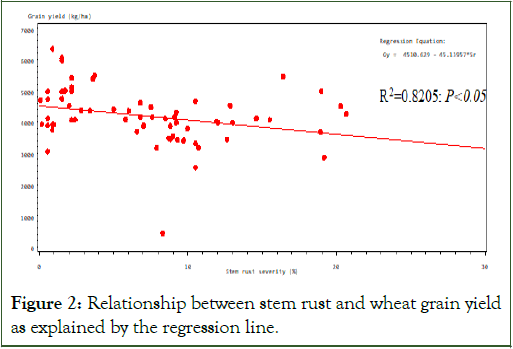
Figure 2: Relationship between stem rust and wheat grain yield as explained by the regression line.
Whereas, the relationship between above ground biomass yield and stem rust was assessed in similar way by using the simple linear regression model and it showed the existence of statistically significant association between the parameters and it has been explained by the regression line (Figure 3).
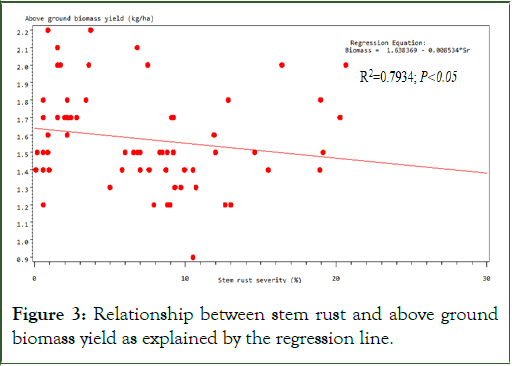
Figure 3: Relationship between stem rust and above ground biomass yield as explained by the regression line.
Financial profitability analysis
The financial profitability analysis revealed that the highest MB of 198,498.2 ETB/ha was obtained from Bulala variety that was sprayed twice at 21 days interval with the first spray being before disease occurrence; which is followed MB of 187,188.2 ETB/ ha that was calculated from Bulala variety sprayed 3 times at 14 days interval with the first spray being started before disease occurrence (Table 4).
| Treatment | Yield (kgha-1) | SR (ETB ha-1) | MC (ETB ha-1) | MB (ETB ha-1) | MRR (%) |
|---|---|---|---|---|---|
| Bulala 3A1stOS21DI | 4580.4 | 178635.6 | 2316.75 | 176318.9 | 2013.84 |
| Bekelcha 2A1stOS14DI | 4167.3 | 162524.7 | 1544.5 | 160980.2 | -1156.24 |
| Bulala 2A1stOS21DI | 3682.4 | 143613.6 | 1544.5 | 142069.1 | 803.22 |
| Bulala 3A1stOS14DI | 3804.9 | 148391.1 | 2316.75 | 146074.4 | 708.37 |
| Bulala no spray | 3324.7 | 129663.3 | 0 | 129663.3 | 0 |
| Bulala 2A1stOS14DI | 3752.7 | 146355.3 | 1544.5 | 144810.8 | 980.74 |
| Bekelcha 2A1stOS21DI | 3989.8 | 155602.2 | 1544.5 | 154057.7 | -1604.45 |
| Bulala 1A1stOS | 3831.6 | 149432.4 | 772.25 | 148660.2 | 2459.94 |
| Bekelcha 1A1stOS | 3554.9 | 138641.1 | 772.25 | 137868.9 | -5305.21 |
| Bekelcha no spray | 4585.6 | 178838.4 | 0 | 178838.4 | 0 |
| Bulala 1TBDO | 2986.7 | 116481.3 | 772.25 | 115709.1 | -1806.95 |
| Bekelcha 3A1stOS14DI | 4108.2 | 160219.8 | 2316.75 | 157903.1 | -903.65 |
| Bekelcha 3T21DI1stSBDO | 4435.1 | 172968.9 | 2316.75 | 170652.2 | -353.35 |
| Bekelcha 1TBDO | 4752 | 185328 | 772.25 | 184555.8 | 740.36 |
| Bekelcha 3A1stOS21DI | 3731.6 | 145532.4 | 2316.75 | 143215.7 | -1537.62 |
| Bulala 3T14DI1stSBDO | 4859.1 | 189504.9 | 2316.75 | 187188.2 | 2483 |
| Bekelcha 2T14DI1stSBDO | 4768.7 | 185979.3 | 1544.5 | 184434.8 | 362.34 |
| Bulala 2T21DI1stSBDO | 5129.3 | 200042.7 | 1544.5 | 198498.2 | 4456.78 |
| Bekelcha 3T14DI1stSBDO | 4554.4 | 177621.6 | 2316.75 | 175304.9 | -152.52 |
| Bulala 2T14DI1stSBDO | 4349.1 | 169614.9 | 794.5 | 168820.4 | 4928.52 |
| Bekelcha 2T21DI1stSBDO | 4691.8 | 182980.2 | 794.5 | 182185.7 | 421.31 |
| Bulala 3T21DI1stSBDO | 4484.8 | 174907.2 | 2316.75 | 172590.5 | 1852.91 |
Table 4: Effect of fungicide application regime for stem rust management in durum wheat production on financial profitability.
In contrary, the lowest MB (115,709.1 ETB/ha) was obtained from Bulala variety sprayed once before disease occurrence. On the other hand, the highest MRR (4,928.52%) was calculated from Bulala variety sprayed twice at 14 days interval fungicide spray being started before disease occurrence. This implies that for each 1.00 ETB invested in durum wheat production for stem rust management, there was a gain of 49.29 ETB/ha from Bulala variety.
Conclusion
The results from this study have sufficiently justified the Bale farmers’ practice of spraying ahead of symptom development on plant surface. The top six highest grain yields were recorded from those plots that have received at least one time fungicide spray before disease occurrence with financial profitability In this study, stem rust resulted in significant reduction in Thousand Kernel Weight (TKW) and grain yield in the absence of fungicide spray or sprays that were done after disease occurrence on the plant surface. Reversely, the disease increased the total gain protein content in durum wheat. However, Rex® Duo application significantly reduced stem rust severity and there by significantly improved grain yield and TKW of durum wheat. However, the practical applications of the result of this study basically depend on an efficient disease forecasting and early warning systems that are not reliable in Ethiopia. Therefore, based on the result of this study and practical situation of Ethiopian farming system, wheat growers in Bale and similar agro-ecologies are recommended to produce Bulala variety and spray fungicides 2-3 times at 14 days interval, the first spray should start as the first stem rust pustule is observed on the plant surface in the surrounding farms.
References
- Degete AG, Chala A. Effects of stem rust (Puccinia graminis f. sp. tritici) on yield, physical and chemical quality of durum wheat varieties in East shoa zone, Ethiopia. Am J Agric Forestry. 2019;7(2):78-83.
- Ashenafi GD, Alemayehu C, Bekele H. Effect of Fungicide Spray Schedule on Stem Rust (Puccinia graminis f.sp. tritici) Development and Grain Physical Quality of Durum Wheat in Ethiopia. Int J Curr Res. 2018;10(08):72827-72832.
- Chris G. World Durum Outlook. 2017.
- CIMMYT (International Center for Maize and Wheat Improvement). Sounding the Alarm on Global Stem Rust. An assessment of race Ug99 in Kenya and Ethiopia and the potential for impact in neighboring regions and beyond. Prepared by the expert panel on the tem rust outbreak in Eastern Africa. CIMMYT, Mexico; 2005.
- CIMMYT Economics Program. From agronomic data to farmer recommendations: An economics training manual. CIMMYT; 1988.
- CSA (Central Statistical Authority), 2017/18.Agricultural survey sample. Report on area and production of crops (private peasant holdings, meher season). Statistical Bulletin No 586. Addis Ababa, Ethiopia.
- Hailu E, Woldaeb G, Denbel W, Alemu W, Abebe T, Mekonnen A. Distribution of Stem Rust (Puccinia graminis f. sp. tritici) Races in Ethiopia. Adv Crop Sci Tech. 2015;3(173):2.
- Hailu GM. Bread wheat breeding and genetic research in Ethiopia. In Hailu Gebre-Mariam, Tanner DG, MangistuHuluka (eds). Wheat research in Ethiopia: A historical perspectives. Addis Ababa.1991. pp. 73-93.
- Haldore, H., Borlang, N.E. and Anderson, R.G., 1982. Wheat in he Third World. West View Press. Boulders, Colorado, USA.
- Jin Y, Singh RP, Ward RW, Wanyera RU, Kinyua MI, Njau PE, et al. Characterization of seedling infection types and adult plant infection responses of monogenic Sr gene lines to race TTKS of Puccinia graminis f. sp. tritici. Plant Dis. 2007;91(9):1096-1099.
[Crossref] [Google Scholar] [PubMed]
- Jin Y, Szabo LJ, Pretorius ZA. Virulence variation within the Ug99 lineage. InProceedings of 11th International Wheat Genet Symposium Sydney University Press, Sydney, Australia. 2008 (pp. 4-6). [Crossref] [Google Scholar] [PubMed]
- Mueller DS, Jeffers SN, Buck JW. Effect of timing of fungicide applications on development of rusts on daylily, geranium, and sunflower. Plant Dis. 2004;88(6):657-661.
[Crossref] [Google Scholar] [PubMed]
- Ochoa J, Parlevliet JE. Effect of partial resistance to barley leaf rust, Puccinia hordei, on the yield of three barley cultivars. Euphytica. 2007;153:309-312.
- Peterson RF, Campbell AB, Hannah AE. A diagrammatic scale for estimating rust intensity on leaves and stems of cereals. Canadian J Res. 1948;26(5):496-500.
- Peturson B, Newton M, Whiteside AG. The effect of leaf rast on the yield and quality of Wheat. Canadian J Res. 2011;23:105-114.
- Pretorius ZA, Singh RP, Wagoire WW, Payne TS. Detection of virulence to wheat stem rust resistance gene Sr31 in Puccinia graminis. f. sp. tritici in Uganda. Plant Dis. 2000;84(2):203.
[Crossref] [Google Scholar] [PubMed]
- Roelfs AP, Groth JV. A comparison of virulence phenotypes in wheat stem rust populations reproducing sexually and asexually. Phytopathol. 1980;70(9):855-62.
- SAS Institute. SAS/STAT guide for personal computers, version 6.12 edition. Cary, NC:SAS Institute. 1998.
- Shaner G, Finney RE. The effect of nitrogen fertilization on the expression of slow-mildewing resistance in Knox wheat. Phytopathol. 1977;67(8):1051-6.
Citation: Teshomea E, Koraa D (2024) Critical Time of Fungicide Spray for the Management of Stem Rust (Puccinia graminis f.sp. tritici) and its Effect on Grain Yield, Yield Components and Protein Content of Durum Wheat (Triticum durum L.). J Plant Pathol Microbiol. 15:741.
Copyright: © 2024 Teshomea E, et al. This is an open access article distributed under the terms of the Creative Commons Attribution License, which permits unrestricted use, distribution, and reproduction in any medium, provided the original author and source are credited.
